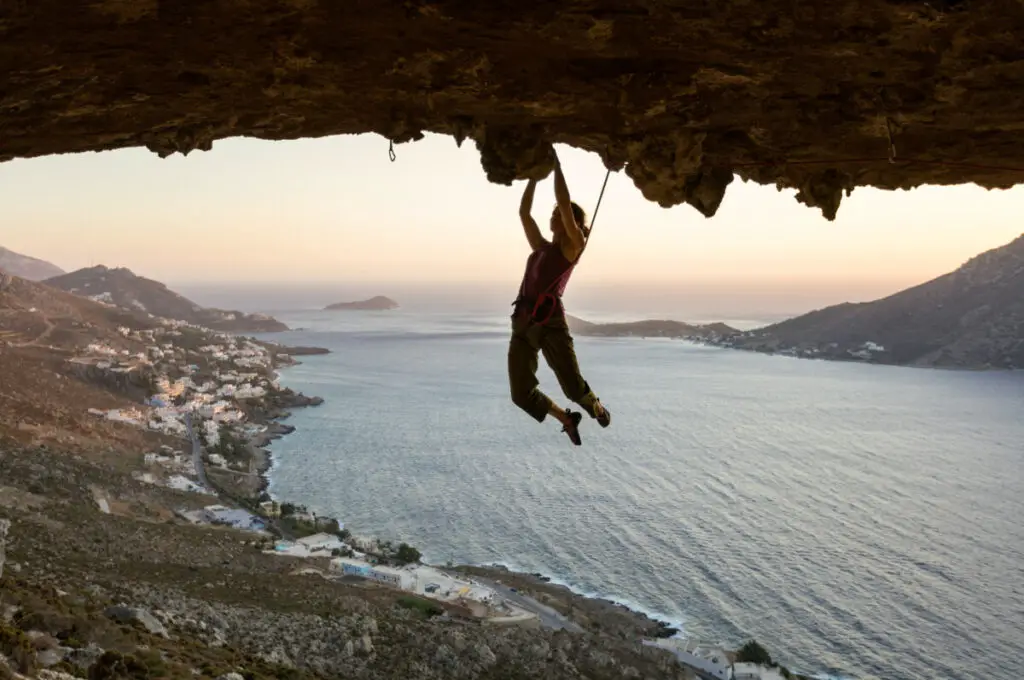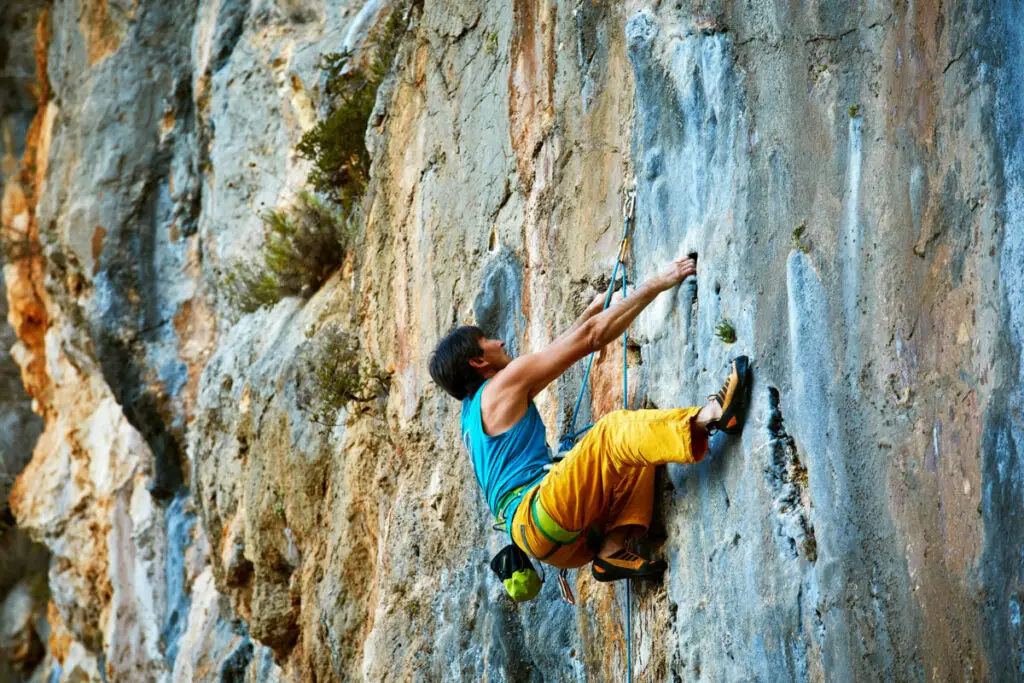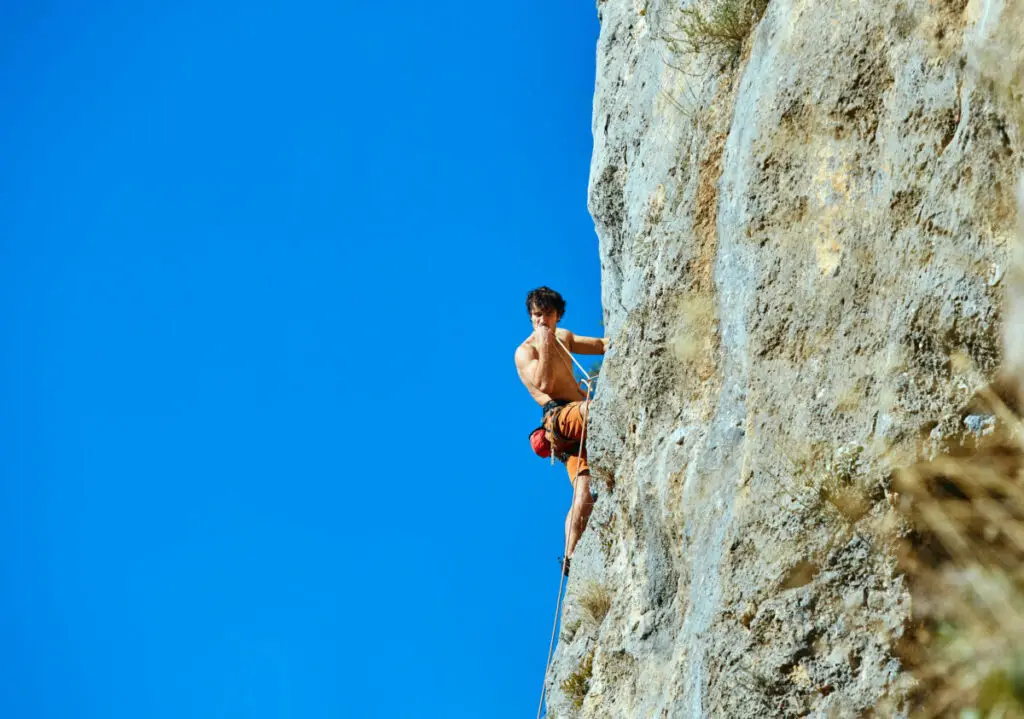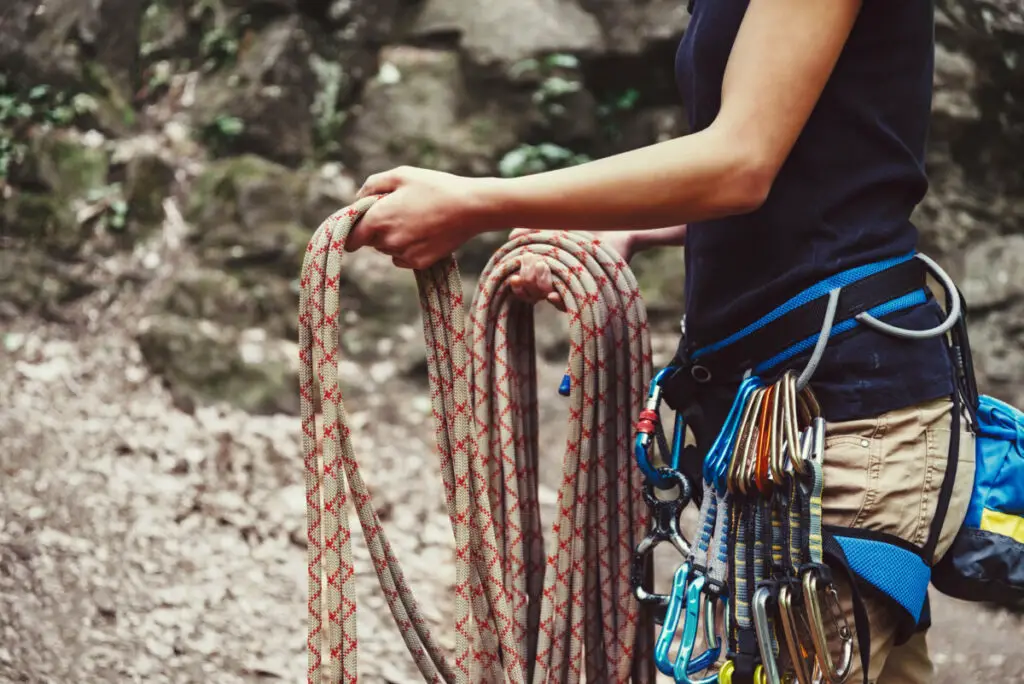
When it comes to rock climbing, people often just want to throw on their favorite pair of pants. If it is hot, they want to put on their favorite pair of shorts. However, are pants or shorts better to wear while rock climbing?
Pants are better to wear than shorts when rock climbing. Not only do pants offer protection from scrapes and insects, but climbing pants are specifically designed to have the extra stretch that allows for the mobility needed to climb safely. Pants function well in all types and forms of climbing.
Although pants are the best option, the clothes you wear climbing should be based on your personal needs and preferences. That being said, let’s talk a bit more about what you need to think about when choosing your climbing outfit and the pros and cons of both pants and shorts.
Things to Consider
When trying to make any clothing choice, there are a few things you need to consider before making a final decision. With climbing clothes, the main things to consider are how much protection you receive and the mobility it provides. These factors are all influenced by the weather and the type of climbing you do. Last but not least, you’ll want to think about the price and style of your clothing choice.
Protection
Rock climbing is a dangerous alpine sport. With that in mind, it is essential that a climber always practices safety techniques and guidelines. Now, the protection you’ll need from your clothing while climbing isn’t as serious or necessary as the protection of the rope or your harness, but it is still important.
Shorts offer little protection from bugs and the common scrapes and bruises that almost always occur when climbing as they only cover half of your leg. Pants are much better at preventing scrapes with their full coverage and often thicker material. When you wear pants, you are also protected from bugs such as mosquitos and ticks that so often carry diseases. The more protection you get from your clothes, the more likely they are to be durable and last against wear from the rock and your rope and harness.
Weather
The weather that you are climbing in will also make an impact on what bottoms will be best for you to wear. Climbing outdoors is generally done in better weather like rain, snow, and ice can make the rock slippery and dangerous. While shorts allow you to be cool in the hottest weather, there are climbing pants that are lightweight and breathable. Many climbing pants also roll up into capris which can help a bit in the heat. Most climbers wear shorts only when it is too hot for another option, but that isn’t the best for all environments. One avid climber said,
“Most often I just wear shorts… I live on a really humid island and personally can’t stand sweat all over my clothes”
– Anonymous climber
Mobility
Mobility may be the most important factor when deciding what to wear climbing. While rock climbing, you will your clothes to allow as much movement as possible as you contort your body into different positions to get up the wall. Techniques such as a drop knee, high step, mantle, or even a heel hook may prove to be impossible if your leg movement is restricted.
Shorts can provide high mobility and allow you complete freedom of movement that can be a little harder to find in pants. A normal, everyday pair of pants won’t cut it in the climbing gym or in the outdoors. However, most specially designed climbing pants usually have a diamond gusset. A diamond gusset is an extra length of fabric under the crotch that allows for more movement and flexibility. Leggings or athletic tights are also a common option for climbers as they allow for quite a bit of mobility.

Type of Climbing
Although it may not be quickly apparent to those outside the climbing community, there are quite a few different types of rock climbing. The different variations of rock climbing all have the same basic concepts but vary in techniques, the gear used, and the location.
- Free soloing- The concept of free soloing was brought into the general public’s eye in 2018 with the release of the documentary Free Solo, which features the famed climber Alex Honnold. Free soloing requires no gear as you climb the wall without any rope. Very few climbers attempt free soloing as it is extremely dangerous.
- Free climbing– Free climbing is the most common type of climbing where you are tied to a rope and use your hands and feet to climb your way to the top. Within free climbing, there are two types- Sport Climbing and Traditional “Trad” Climbing. In sport climbing, you connect quickdraws to preplaced bolts so you can clip in as you go. While completing a trad route, climbers use removable hardware called “protection” or “pro” to secure them to the rockface.
- Bouldering– Bouldering is similar to free soloing but has a lot less risk involved. Bouldering routes don’t usually reach much higher than 15 feet and climbers place a crash pad at the base to protect climbers from falls. Bouldering is a great form of climbing to do alone if you don’t have a climbing buddy or if you are inexperienced with ropes.
- Deep Water Soloing- As the name suggests, deep water soloing is also done without a rope, but instead of having a crash pad below them like in bouldering, climbers fall into a body of water. This is a newer form of climbing, with the first competition of its kind held in 2013.
No matter what type of climbing you do, it is essential to be properly outfitted.
Style & Price
The style and price of your shorts or pants are also worth consideration. Pants and shorts that are specifically designed for climbing are often a tad more expensive than your run-of-the-mill athletic wear. Since they require less material to be produced, climbing shorts are less expensive than climbing pants which can cost upwards of $100. Style-wise, shorts would be a better option for someone who likes to show off their legs and isn’t worried about getting cut up. Climbing pants and shorts are generally produced in more neutral colors, but you can find ones in a fit, style, and color that suits you.

Benefits of Pants
When I texted my brother (who has been an avid rock climber for over eight years and has also sent routes on multiple continents) about whether he preferred shorts or pants while climbing, he responded quickly “pants” with no explanation. Unlike him, I’ll give you the explanation as to why pants are generally the preferred choice for rock climbers.
As we talked about earlier, pants offer your legs the best protection possible. The length and thickness of pants mean that you will get fewer scrapes on your knees and shins as they inevitably make contact with the rock during a fall or ill-timed move. Even if you do your best to avoid getting scrapes and cuts, you likely will still get them and not notice until you finish the climb.
Pants are also a great option for all weather and seasons. I have a pair of climbing pants from prAna that I have used both indoors and outdoors that I recommend to all my climbing buddies. They have served me well in winter, spring, summer, and fall in the towering Wasatch Mountains. Mobility-wise, my pants have been great. However, you do have to make sure you don’t wear too loose-fitting pants since the extra material can catch on jagged rocks. Some other climbers said,
“Pants stay in place better than shorts and don’t ride up in the crotch area. Slim fitting pants also have less bulk around the harness legs. Basically [pants are] just more comfortable… They’re stretchy so you get the protection of a pant without being restricted”
– anonymous climber
The versatility of climbing pants lends them to every style of climbing, whether you have mere months or several years of climbing experience under your belt.
Benefits of Shorts
Shorts are best suited for those climbing in hot weather, but there is a tradeoff to sacrificing the protection of pants for the comfort of shorts. Some climbers embrace the constant wear and tear on their legs and treasure the scars, scrapes, and bruises as memories of the route they got them on, calling it a “lifestyle choice”.
“I wear shorts that do not go past the knees. Sure, scrapes happen. You just need to wear them as a badge of pride!”
– Experienced Climber
Along with the better temperature control and gnarly badges of honor you get wearing shorts, they are pretty great mobility-wise. As long as they are the right fit, you can move your legs pretty much anywhere you want them. The only problem is that loose-fitting shorts tend to ride up in your crotch area or bunch up around the harness.
Just like some climbers swear by pants, a good amount swear by shorts as well. Finding the right bottoms to wear climbing is really up to you and your preferences. Now that you know the pros and cons of using shorts or pants when climbing, you can make an informed decision.
The Importance of Good Gear
Being correctly equipped from head to toe is a must in rock climbing- one of the more dangerous alpine sports. If you are climbing and don’t have the right gear, or are using gear that hasn’t been properly maintained, you are in for a rough and possibly life-threatening trip.
Bringing along proper safety gear such as a harness, rope, ATC, helmet, shoes, and quickdraws is a necessity. Apart from the gear you bring, you also need to check the gear that may already be in the rock. Rusty or loose bolts or anchors may not be able to withstand the stress of a fall. Heat, friction, and moisture can all affect the reliability of your gear, so keep an eye out for those factors.
That being said, you need to know when it is time to retire your gear. A rope usually needs to be retired after using it consistently for three years or earlier if you use it more frequently, shows signs of damage, or sustained a fall with extreme loads. A climbing harness should be retired if you’ve had it for about seven years.
Even while in storage, climbing gear experiences wear that could compromise it. Carabiners, ATCs, and belay devices need to be retired if they have been dropped from a significant height or when they show signs of excessive wear. A helmet should be retired after ten years or if it is dented, cracked, or damaged in another way.

Although your clothing is not life-rated gear, it does in fact affect your safety while doing a route. For example, if your shirt or pants are too loose, they can catch on the rock or even your belay device. As a woman, I’d advise those with long hair to pull it back and out of the way, as I have experienced my hair getting caught in my belay device too often while rappelling off of a route. It is not a situation you want to find yourself in, trust me.
I have noticed that when I am more comfortable and confident in my clothes, I send it better than when I’m not. Climbing can be emotionally stressful, especially when you take an unexpected fall or become frustrated when you just can’t get past that crux.
I find that wearing something I am comfortable in gives me one thing less to worry about when I am attempting to send it and may be out of my element on the wall. You never want to get to a point in the wall where you can’t go any further because you are restricted by what you are wearing. I can’t even imagine the disappointment and frustration I would feel if that happened to me.

